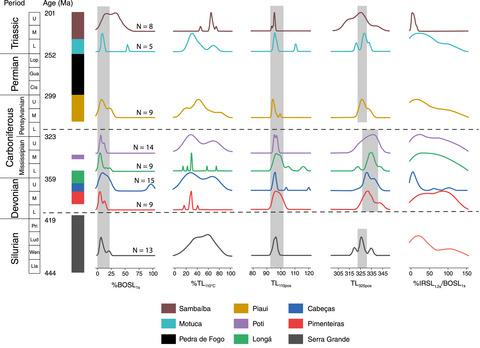当前位置:
X-MOL 学术
›
Basin Res.
›
论文详情
Our official English website, www.x-mol.net, welcomes your feedback! (Note: you will need to create a separate account there.)
Luminescence signals of quartz and feldspar as new methods for stratigraphic discrimination and provenance analysis of siliciclastic successions: The case of the Parnaíba Basin (Brazil) of West Gondwana
Basin Research ( IF 3.2 ) Pub Date : 2021-07-28 , DOI: 10.1111/bre.12590 Ian del Río 1 , André O. Sawakuchi , Ana M. Góes 1 , Maria Helena 1 , B.M. Hollanda 1 , Laura Y. Furukawa 1 , Naomi Porat 2 , Mayank Jain 3 , Thays D. Mineli 1 , Francisco de Assis Negri 4
Basin Research ( IF 3.2 ) Pub Date : 2021-07-28 , DOI: 10.1111/bre.12590 Ian del Río 1 , André O. Sawakuchi , Ana M. Góes 1 , Maria Helena 1 , B.M. Hollanda 1 , Laura Y. Furukawa 1 , Naomi Porat 2 , Mayank Jain 3 , Thays D. Mineli 1 , Francisco de Assis Negri 4
Affiliation

|
Luminescence characteristics of quartz and feldspar allow to discriminate sediments from different source areas. Particularly, sensitivity of optically stimulated luminescence (OSL) and thermoluminescence (TL) signals of quartz and infrared-stimulated luminescence (IRSL) of feldspar from Quaternary sediments has been used for provenance analysis. These properties change due to source area denudation rates and sediment reworking, which drive the number of burial irradiation-solar exposure cycles of sediment grains in surface systems. Here, we use for the first time a similar approach to interpret the geomorphic conditions of source areas of Silurian to Triassic siliciclastic sedimentary units of the intracratonic Parnaíba Basin in northeast Brazil. Luminescence measurements were performed on sand grains, and statistical tests were applied to evaluate differences in luminescence properties within and across stratigraphic units. We explored the position of well-known “110°C” (TL110) and “325°C” (TL325) TL peaks of quartz as proxies to discriminate stratigraphic units with similar lithological assemblages. OSL and TL sensitivities as well as the dominance of the so-called fast OSL component increase from Silurian to Triassic sedimentary units, while the IRSL sensitivity decreases towards younger stratigraphic units. These patterns point to source areas with decreasing denudation rate and higher sediment recycling over basin filling time, leading to decreasing feldspar concentration and quartz luminescence sensitisation. Major changes in luminescence properties coincide with regional unconformities. This is attributed to physical landscape changes leading to shifts in the relief of source areas and basin sediment recycling. The TL110 peak position is similar across stratigraphic units, but the TL325 peak position has significant variation, with values between 324°C and 334°C, allowing its use for stratigraphic discrimination. Changes in OSL and TL characteristics of quartz sediment grains are preserved during long-term burial (108 Ma), representing a new tool for interpreting basin evolution and to perform stratigraphic analysis of ancient siliciclastic successions.
中文翻译:

石英和长石的发光信号作为硅质碎屑层序地层鉴别和来源分析的新方法:以西冈瓦纳的 Parnaíba 盆地(巴西)为例
石英和长石的发光特性允许区分来自不同来源区域的沉积物。特别是,石英的光学受激发光 (OSL) 和热释光 (TL) 信号以及来自第四纪沉积物的长石的红外激发发光 (IRSL) 的灵敏度已被用于物源分析。由于源区剥蚀率和沉积物再加工,这些特性会发生变化,从而推动地表系统中沉积物颗粒的埋藏辐照 - 太阳暴露循环的数量。在这里,我们首次使用类似的方法来解释巴西东北部克拉通内 Parnaíba 盆地志留系至三叠系硅质碎屑沉积单元的源区地貌条件。对沙粒进行发光测量,并应用统计测试来评估地层单元内和跨地层单元的发光特性差异。我们探索了著名的“110°C”(TL110 ) 和“325°C” (TL 325 ) 石英的 TL 峰作为区分具有相似岩性组合的地层单元的代理。OSL 和 TL 敏感性以及所谓的快速 OSL 成分的优势从志留纪到三叠纪沉积单元增加,而 IRSL 敏感性向年轻的地层单元降低。这些模式表明,随着盆地填充时间的推移,源区剥蚀率降低,沉积物回收率更高,导致长石浓度降低和石英发光敏化。发光特性的主要变化与区域不整合相吻合。这归因于物理景观变化导致源区和盆地沉积物再循环的变化。TL 110不同地层单位的峰位相似,但 TL 325峰位变化显着,值在 324°C 和 334°C 之间,可用于地层判别。石英沉积物颗粒的 OSL 和 TL 特征的变化在长期埋藏期间(10 8 Ma)得以保留,是解释盆地演化和进行古代硅质碎屑序列地层分析的新工具。
更新日期:2021-07-28
中文翻译:

石英和长石的发光信号作为硅质碎屑层序地层鉴别和来源分析的新方法:以西冈瓦纳的 Parnaíba 盆地(巴西)为例
石英和长石的发光特性允许区分来自不同来源区域的沉积物。特别是,石英的光学受激发光 (OSL) 和热释光 (TL) 信号以及来自第四纪沉积物的长石的红外激发发光 (IRSL) 的灵敏度已被用于物源分析。由于源区剥蚀率和沉积物再加工,这些特性会发生变化,从而推动地表系统中沉积物颗粒的埋藏辐照 - 太阳暴露循环的数量。在这里,我们首次使用类似的方法来解释巴西东北部克拉通内 Parnaíba 盆地志留系至三叠系硅质碎屑沉积单元的源区地貌条件。对沙粒进行发光测量,并应用统计测试来评估地层单元内和跨地层单元的发光特性差异。我们探索了著名的“110°C”(TL110 ) 和“325°C” (TL 325 ) 石英的 TL 峰作为区分具有相似岩性组合的地层单元的代理。OSL 和 TL 敏感性以及所谓的快速 OSL 成分的优势从志留纪到三叠纪沉积单元增加,而 IRSL 敏感性向年轻的地层单元降低。这些模式表明,随着盆地填充时间的推移,源区剥蚀率降低,沉积物回收率更高,导致长石浓度降低和石英发光敏化。发光特性的主要变化与区域不整合相吻合。这归因于物理景观变化导致源区和盆地沉积物再循环的变化。TL 110不同地层单位的峰位相似,但 TL 325峰位变化显着,值在 324°C 和 334°C 之间,可用于地层判别。石英沉积物颗粒的 OSL 和 TL 特征的变化在长期埋藏期间(10 8 Ma)得以保留,是解释盆地演化和进行古代硅质碎屑序列地层分析的新工具。



























 京公网安备 11010802027423号
京公网安备 11010802027423号